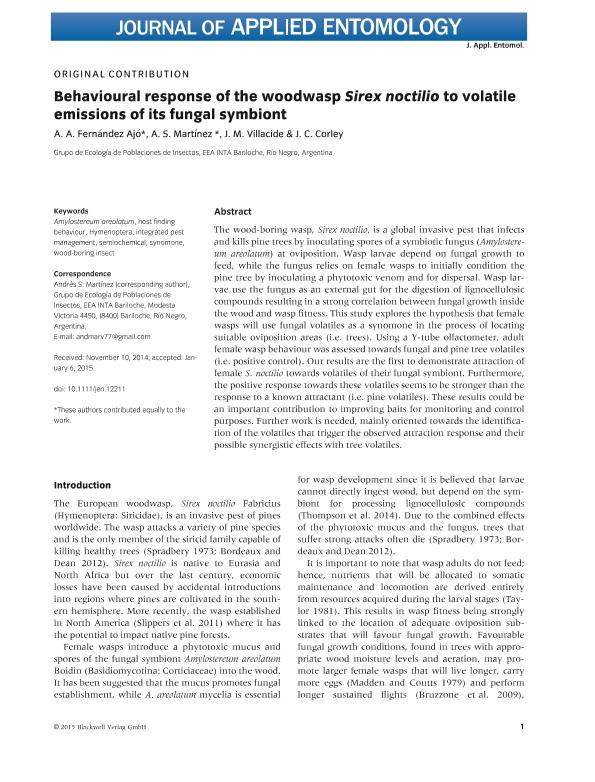Artículo
Behavioural response of the woodwasp Sirex noctilio to volatile emissions of its fungal symbiont
Fernández Ajo, A. A.; Martinez Von Ellrichshausen, Andres Santiago ; Villacide, Jose Maria; Corley, Juan Carlos
; Villacide, Jose Maria; Corley, Juan Carlos
 ; Villacide, Jose Maria; Corley, Juan Carlos
; Villacide, Jose Maria; Corley, Juan Carlos
Fecha de publicación:
10/11/2015
Editorial:
Blackwell Verlag GmbH
Revista:
Journal of Applied Entomology
ISSN:
1439-0418
Idioma:
Inglés
Tipo de recurso:
Artículo publicado
Clasificación temática:
Resumen
The wood-boring wasp, Sirex noctilio, is a global invasive pest that infectsand kills pine trees by inoculating spores of a symbiotic fungus (Amylostere-um areolatum) at oviposition. Wasp larvae depend on fungal growth tofeed, while the fungus relies on female wasps to initially condition thepine tree by inoculating a phytotoxic venom and for dispersal. Wasp lar-vae use the fungus as an external gut for the digestion of lignocellulosiccompounds resulting in a strong correlation between fungal growth insidethe wood and wasp fitness. This study explores the hypothesis that femalewasps will use fungal volatiles as a synomone in the process of locatingsuitable oviposition areas (i.e. trees). Using a Y-tube olfactometer, adultfemale wasp behaviour was assessed towards fungal and pine tree volatiles(i.e. positive control). Our results are the first to demonstrate attraction offemale S. noctilio towards volatiles of their fungal symbiont. Furthermore,the positive response towards these volatiles seems to be stronger than theresponse to a known attractant (i.e. pine volatiles). These results could bean important contribution to improving baits for monitoring and controlpurposes. Further work is needed, mainly oriented towards the identifica-tion of the volatiles that trigger the observed attraction response and theirpossible synergistic effects with tree volatiles.
Archivos asociados
Licencia
Identificadores
Colecciones
Articulos(CCT - PATAGONIA NORTE)
Articulos de CTRO.CIENTIFICO TECNOL.CONICET - PATAGONIA NORTE
Articulos de CTRO.CIENTIFICO TECNOL.CONICET - PATAGONIA NORTE
Citación
Fernández Ajo, A. A.; Martinez Von Ellrichshausen, Andres Santiago; Villacide, Jose Maria; Corley, Juan Carlos; Behavioural response of the woodwasp Sirex noctilio to volatile emissions of its fungal symbiont; Blackwell Verlag GmbH; Journal of Applied Entomology; 139; 9; 10-11-2015; 654-659
Compartir
Altmétricas



